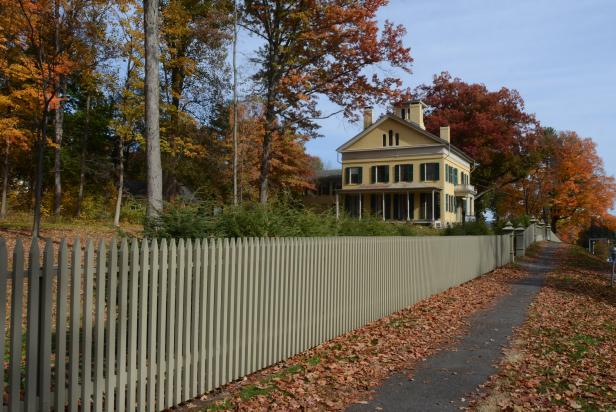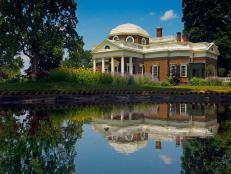Explore Famous Writers' Homes
Music fans have Graceland, Abbey Road, and now, with the passing of Prince, Paisley Park. For book lovers--and aspiring writers--it's all about the places our favorite authors lived. These homes deserve a spot on any bibiliophile's list.
The Mark Twain House & Museum, Hartford, CT

John Groo/Mark Twain House and Museum
Mark Twain said the happiest years of his life were spent in his family's home in Hartford. But the house, built in 1874, cost a fortune to construct: about $45,000 for a 25-room residence that measured 11,500 square feet. When financial problems loomed, the Twains moved to Europe. After daughter Suzy’s death, the grieving family could never bear to live in the Hartford house again, and sold it in 1903. It was an amazing house in the late Victorian era, boasting seven bathrooms with running water, an early telephone, and a conservatory with a fountain and lush plants. Close your eyes when you enter the billiard room, which served as the popular author's office and retreat, and imagine you hear the sound of billiard balls clacking together.

John Groo/Mark Twain House and Museum
Rowan Oak, Oxford, MS
Nobel Prize-winning author William Faulkner sought peace in Oxford, Mississippi, where he bought a primitive Greek revival-style home he called "Rowan Oak." The house is named for the rowan tree, or mountain ash, which symbolizes protection. The property includes approximately 29 acres of land located near the Square in Oxford, and was purchased by the University of Mississippi after the author's death. Tours are available; see the website for days and times. The grounds are free to visit and open to the public year-round, from dawn to dusk. And tour the rest of Oxford too, which has become its own literary hub, with many contemporary authors in residence in this beautiful Southern town.

Robert Jordan/© Ole Miss Communications
The Emily Dickinson Museum & Properties, Amhert, MA
Born in in 1830, Emily Dickinson, one of America's most famous poets, was practically a recluse throughout her lifetime, seldom going out or entertaining. Today, visitors can tour her residence, The Homestead, and a nearby house, The Evergreens, which belonged to her brother and his family. Dickinson never married, and most of her work was published only after her death. In the Evergreens, you'll find well-preserved nineteenth-century furnishings and décor.

Emily Dickinson Museum
The Homestead has been repainted in period colors, and the interior has been intrepreted to show how the home looked while it was occupied. Check the site for a schedule of walking tours, poetry nights and poetry discussion groups.

Emily Dickinson Museum
Harriet Beecher Stowe House, Hartford, CT
Harriet Beecher Stowe, author of the 1852 anti-slavery novel, Uncle Tom’s Cabin, was a neighbor of Mark Twain's, so while you're in Hartford, leave time to see both homes. Stowe moved into her residence, which features a steep hip roof, bay windows and porches, in 1873. The house also shows influences of Gothic-revival style, and its simple, table, chairs and other furnishings remain much as they were during Stowe's lifetime. Look for the author's paintings and sketches on the second floor. A Wardien case, a kind of terrarium, and Victorian-style gardens around the residence suggest her love of the natural world.

Harriet Beecher Stowe Center; Hartford; CT
The House of the Seven Gables and Nathaniel Hawthorne Birthplace, Salemn, MA
“Halfway down a by-street in one of our New England towns stands a rusty wooden house, with seven acutely peaked gables.” When Nathaniel Hawthorne wrote those opening lines in his 1851 novel, The House of the Seven Gables, he was describing the home of John Turner, a Salem sea captain and merchant. Later the house was sold to the Ingersoll family, and today, the Turner-Ingersoll Mansion is open to the public as an example of 17th and 18th century American architecture and maritime history.

The House of the Seven Gables Settlement Association
Hawthorne himself was born in a simple, Georgian-style home built in 1750. Don’t miss the museum, Seaside Gardens, and other historic buildings on this site. Plan to visit in October for two “spirited” theatrical events. "Spirits of the Gables" brings characters from The House of the Seven Gables to life, while ” Legacy of the Hanging Judge” portrays the events of the Salem Witch Trails of 1692.

The House of the Seven Gables Settlement Association
Ernest Hemingway Home & Museum, Key West, FL
“Papa” Hemingway, as he was known, lived in Key West for more than a decade. His home is decorated with trophies from his safaris in Africa and the American West, and features many windows that open to the cooling breezes. Built in 1851, the Spanish-Colonial style house includes the first in-ground pool installed in Key West, built for a jaw-dropping $20,000. Look for a penny embedded in the cement surrounding the pool; Hemingway put it there, saying it was the last cent he had, after paying construction costs.

Rob O’Neal Photography
According to legend, the beloved six-toed cats that prowl the property descended from a pet given to Hemingway by a local sea captain. Like Harriet Beecher Stowe's home, Hemingway's home is also a delight of native botanicals, so don't forget to stroll through the magnificent, lush garden.

Rob O’Neal Photography
The Steinbeck House, Salinas, CA
Pulitzer Prize-winning novelist John Steinbeck wrote about many important social and economic issues and is probably best known for The Grapes of Wrath, his story about the hardships of life during the Great Depression and the 1930s Dust Bowl. Steinbeck was born and brought up in a Queen Anne-style Victorian home; seasonal tours are available. The home, which is listed on the National Register of Historic Places, has been renovated and includes a museum, gift shop and a restaurant where you can stop for tea or lunch, or book a special event.

The Steinbeck House
Now affiliated with the Atlanta History Center, the Margaret Mitchell House is actually an apartment. Until her tragic death in 1949, Mitchell, author of Gone with the Wind, lived in a Tudor Revival building on Atlanta's Crescent Avenue. Constructed in 1899, the building was later converted into the 10-unit Crescent Apartments. Mitchell and her husband moved there in 1925 and affectionately nicknamed their home, “The Dump.” The once-abandoned building has been restored and is now a popular venue for literary events. Look for many original architectural features in Mitchell's apartment, including a leaded glass window she often gazed from while writing.










